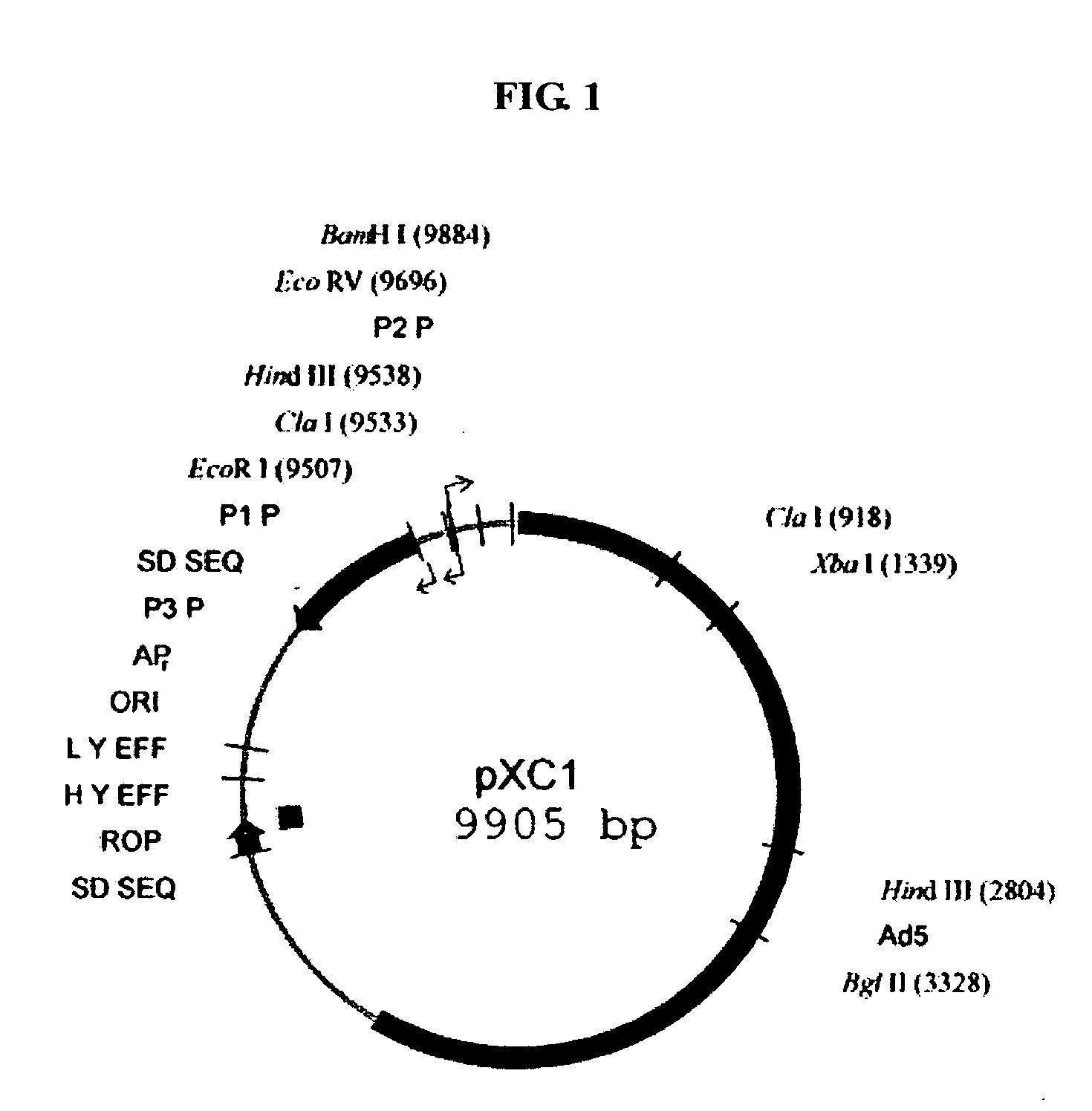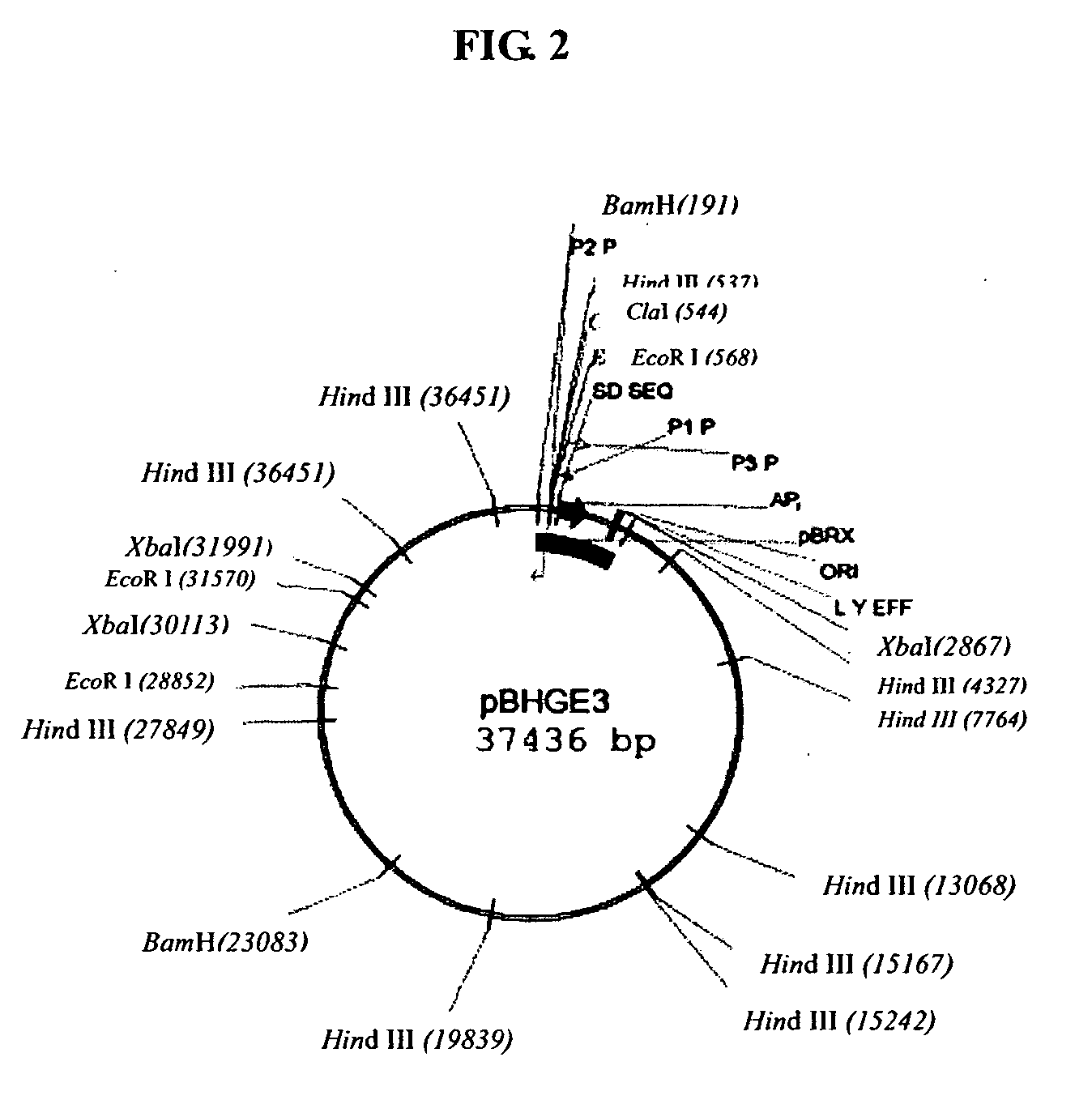Construct of tumor-selective recombinant adenovirus, method for preparing the same and use thereof
a technology of adenovirus and construct, which is applied in the field of human adenovirus type 5 (adv5) recombinant construct, can solve the problems of insufficient killing effect of adenovirus on tumor cells far from the injection site, vectors with minor effects on normal cells, and most of the therapeutic agents used face an austere challenge, etc., and achieve good tumor-selective replication and high therapeutic effect.
- Summary
- Abstract
- Description
- Claims
- Application Information
AI Technical Summary
Benefits of technology
Problems solved by technology
Method used
Image
Examples
example 1
Construct of pXC1 Mutant (Δ920-946pXC1)
1. Materials
[0056] Plasmid pXC1: provided by Microbix Biosystem Inc. (Toronto, Ontario, Canada, Catalogue No. PD-01-03), comprising a 21-5790 nt sequence of human adenovirus type 5 (ADV5), whose sketch map is shown in FIG. 1, in which the 194-358 nt sequence is a packaging signal of ADV5, the 560-1112 nt and 1229-1545 nt sequences are coding sequences of E1A functional protein, the 9883-9888 nt sequence involves a BamHI cleavage site, and the 1338-1343 nt sequence involves an XbaI cleavage site.
[0057] Primer 1: 5′-CG GGA TCC GGG CCC CCA TTT CC-3′ (the underlined part being a BamH cleavage site).
[0058] Primer 2: 5′-GTC ACT GGG TGG GAT CAC CTC CGG TAC MG-3′ (the underlined part being complementary to primer 3).
[0059] Primer 3: 5′-GAG GTG ATC GAT CCA CCC AGT GAC GAC GAG-3′ (the underlined part being partially complementary to primer 2).
[0060] Primer 4: 5′-TGC TCT AGA CAC AGG TGA TGT CG-3′ (the underlined part being an XbaI cleavage site).
...
example 2
Construction of Δ920-946ADV5 Recombinant Adenovirus
[0068] pBHGE3 plasmid was purchased from Microbix Biosystem Inc. (Toronto, Ontario, Canada, Catalogue No. PD-01-12). The plasmid comprises all the ADV5 genomic sequence except that an artificial sequence was used instead of the sequence of 194-358 nt (ADV5 packaging signal). The whole length of the plasmid was 37436 bp whose sketch was shown in FIG. 2.
Preparation of Δ920-946ADV5 Recombinant Adenovirus Constructs
[0069] (1). 7.5×105 of 293 cells (ATCC, U.S.A., Catalogue No.: CRL-1573) were seeded in a 15 cm culture plate with a 10% FBS DMEM culture medium. The number of the cells reached 1-1.5×106 next day, of which almost 70% was confluent.
[0070] (2). Preparation of calcium phosphate solution for co-infection 1600 μl of a sterilized 2×HBS solution containing 42 μg of the pBHGE3 and 42 μg of the Δ920-946pXC1 prepared as in Example 1 was prepared, which includes 280 mM NaCl, 43 mM HEPES, 10 mM KCl, and 10 mM Na2HPO4.7H2O, 2% dextr...
example 3
Construction of pCDNA3.1-ΔE3 Subclone Vector
[0085] The whole name of ADV5 E3 is ADV5 early region 3 which encodes 7 proteins with an endogenous promoter. The sequence, structure and function of ADV5 E3 region are respectively as follows (FIG. 3): [0086] 12.5k, 27858-28179 nt, function unclear; [0087] 6.7k, 27547-28736 nt, function unclear; [0088] gp19 k, 28735-29215 nt, binding MHC Class I-like antigen and inhibiting its presentation to the surface of cells, and escaping from CTL's elimination; [0089] ADP, 29419-29770 nt, lysing cells and releasing the adenovirus; [0090] RIDα, 29784-30057 nt, forming complex with RIDβ and preventing lysing of TNF and elimination of FAS antigen; [0091] RIDβ, 30062-30458 nt; and [0092] 14.7k, 30453-30837, inhibiting lysing of TNF.
[0093] The objective of the experiment is to delete a 28530-29355 nt sequence from E3 region and for inserting a foreign therapeutical gene in E3 6.7k / gp 19k region of a recombinant adenovirus.
[0094] Deletion of a 28532-29...
PUM
| Property | Measurement | Unit |
|---|---|---|
| concentration | aaaaa | aaaaa |
| volume | aaaaa | aaaaa |
| volume | aaaaa | aaaaa |
Abstract
Description
Claims
Application Information
 Login to View More
Login to View More - R&D
- Intellectual Property
- Life Sciences
- Materials
- Tech Scout
- Unparalleled Data Quality
- Higher Quality Content
- 60% Fewer Hallucinations
Browse by: Latest US Patents, China's latest patents, Technical Efficacy Thesaurus, Application Domain, Technology Topic, Popular Technical Reports.
© 2025 PatSnap. All rights reserved.Legal|Privacy policy|Modern Slavery Act Transparency Statement|Sitemap|About US| Contact US: help@patsnap.com



